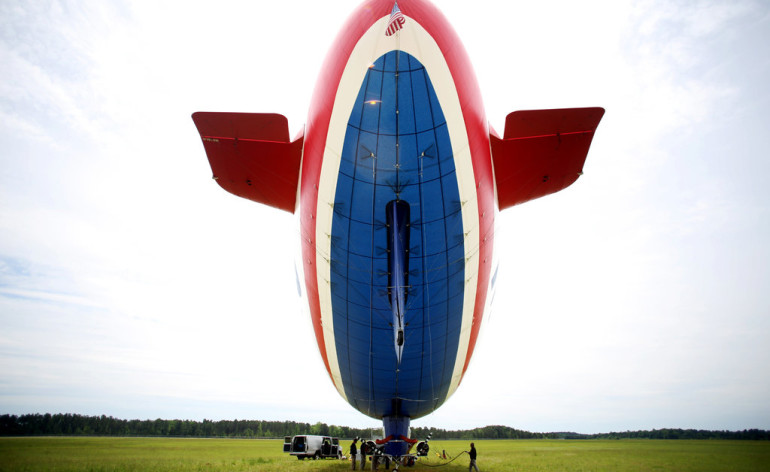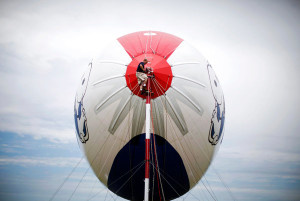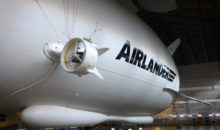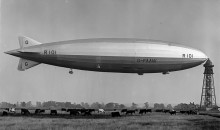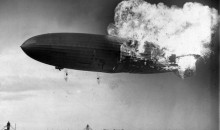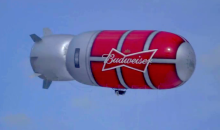MetLife Blimp now an Integral Part of PGA Tour Telecasts
Aboard Snoopy One, above Charlotte, N.C. — Like scores of other golf spectators at a PGA Tour event, Andrew Murray chooses where to position himself by consulting a course map. By the end of the week, his legs are leaden from the effort of tracking the leaders.
The weariness is worth it because Murray’s vantage point is consistently the best, enabling him to find the occasional wayward drive that has come to rest in a stand of trees, hidden from everyone else’s view, or the errant approach nestled deep in the sand that nobody else has spotted.
Murray is an airship pilot, and this weekend he and Mark Finney are taking turns manning MetLife’s Snoopy One blimp during CBS’s telecast of the Wells Fargo Championship at Quail Hollow Club.
“Golf is probably the hardest thing I’ve ever done,” said Murray, whose assignments have included N.F.L. games and Nascar races. “You have to worry about sun angles and shadows on the course.”
Murray was in the blimp’s gondola at midmorning Friday, speaking from his seat, which has wheel controls on each side.
“It’s like flying a wheelchair,” Murray said, joking, to the two guests taking the place of the camera operator and television equipment that are his usual crew and cargo.
Flying under a thick canopy of clouds, Murray piloted his passengers on a “float-by” of the course before CBS’s Friday telecast. The blimp and tournament golf began as an arranged marriage brokered by the renowned CBS Sports producer Frank Chirkinian.
In the beginning, the airship views were all for show, with the focus on producing pretty panoramic pictures for the telecast. Over the years, the relationship has deepened and become much richer, with Murray and the other pilots now considered an integral part of the television crew.
The overhead images from a camera mounted to the front of the blimp give new meaning to the term high definition.
“At first, the blimp was used basically just to show a wide shot of the area,” said Lance Barrow, who learned at Chirkinian’s elbow before succeeding him as the network’s sports producer in 1997. “Now it has become a vital part of our coverage. I couldn’t imagine putting on a broadcast without it.”
Thursday’s opening round had been a long one for Murray, who spent more than six hours in the two-engine, propeller-driven airship with rudders that he controls with his feet. Except for a GPS unit, which looked like the ones mounted in cars, and a television monitor, the dashboard resembled the control panel of a Piper Cub, the simple, light World War II-era aircraft.
The retro nature of the airship, which was traveling about 30 miles per hour, led one passenger to ask Murray if anything should be read into a blimp program underwritten by a life insurance provider. He laughed.
“Honestly, airships are the only aircraft that hasn’t scared me yet,” said Murray, a blimp pilot for more than two years.
He added: “An airship is pretty much the easiest thing to fly. I could be hands off as long as the conditions are right.”
Murray would have a hard time convincing Phil Mickelson, a headliner at this year’s Quail Hollow tournament. Mickelson, whose father was a commercial airline pilot, said he was motivated to earn his pilot’s license because he never felt comfortable flying and thought that confronting a fear was the best way to conquer it.
On Thursday, Mickelson said he had never flown in a blimp. “No desire to,” he said, adding, “I just don’t like the aerodynamics of it.” (Nor is a blimp ride on the bucket list of the former world No. 1 Rory McIlroy, who shuddered and said, “I was in a hot-air balloon once and I didn’t like it.”)
Even from 1,500 feet, the blimp’s altitude during golf telecasts, Mickelson, a five-time major winner, was easy to spot Friday. His group, which included the reigning United States Open champion Justin Rose and the former world No. 1 Lee Westwood, had a large, amoeba-like gallery that moved from hole to hole.
Perhaps because of the early hour, few clusters of fans were visible elsewhere on the course. Missing from the field was Tiger Woods, the world No. 1 and 2007 Quail Hollow champion, who is rehabilitating from back surgery.
“I love when Tiger’s playing,” Murray said, “because then my job is just follow Tiger.”
The hour’s ride to the course from Chester Airport in South Carolina was extraordinarily smooth, owing to the cloud cover, Murray said. During the flight, Murray was in contact with the control tower at Charlotte Douglas International Airport, north of the course. He referred to his airship by its tail number instead of its name, as he usually does, he said, because in local jargon, police helicopters are called Snoopy One, Snoopy Two and so forth.
There are back-seat drivers and then there are the voices in Murray’s ear during a telecast. He takes direction from air traffic controllers, the people in the television truck on the ground and the camera operator seated behind him while following the television coverage on the monitor.
“Normally, I carry a course map, so when they’re talking about a hole, I know which one to go to,” Murray said, adding: “We’re not up there hovering around. We’re moving.”
As he maneuvers the blimp over tens of thousands of spectators, sometimes standing like a ship’s captain to get a better view, Murray can feel the tension rising. “I get nervous that I am being too loud for the golfers,” he said.
Murray need not worry. The drone of the blimp overhead has become white noise for the golfers.
“If anything, the blimp helps us,” said Rickie Fowler, who won here in 2012. “They always idle into the wind. So that’s one way you can tell wind direction.”
On windless days when the sun is beating on the players, the blimp is an even more welcome sight.
“It’s like a cloud,” Fowler said.
Having eyes in the sky can save a player a stroke or two. Murray said he and his camera operator often spot balls that people on the ground have lost. While at the controls of Snoopy Two at the match-play event outside Tucson in February, he said, he located a ball feared lost in the native area.
Barrow, the CBS producer, said that when the blimp is airborne, he does not worry about the weather because he knows the pilot has done his homework.
“Every time I see the blimp flying, I know we’re not going to have a thunderstorm any time soon,” he said.
Is the blimp ever a distraction?
With a sparkle in his eye, Stewart Cink said, “Not unless you hit it really high.”
via – NYTimes.com.

